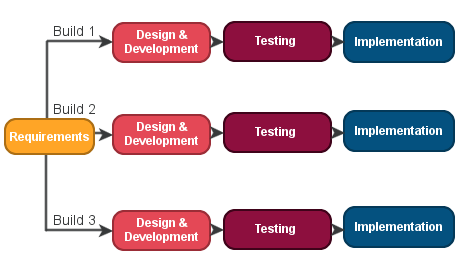

Software Development Life Cycle (SDLC) is extremely vast and full of various development and testing activities, methodologies, techniques, tools, and more. It involves intense planning and management, calculation and preparation. It is only after combining all these efforts of the software engineers that a software or application is successfully developed. Iterative Model is too a part of Software Development Life Cycle.
It is a particular implementation of a software development life cycle that focuses on an initial, simplified implementation, which then progressively gains more complexity and a broader feature set until the final system is complete. In short, iterative development is a way of breaking down the software development of a large application into smaller pieces.
An iterative life cycle model does not start with a full specification of requirements. In this model, the development begins by specifying and implementing just part of the software, which is then reviewed in order to identify further requirements. Moreover, in iterative model, the iterative process starts with a simple implementation of a small set of the software requirements, which iteratively enhances the evolving versions until the complete system is implemented and ready to be deployed. Each release of Iterative Model is developed in a specific and fixed time period, which is called iteration.
Furthermore, this iteration focuses on a certain set of requirements. Each cycle ends with a usable system i.e., a particular iteration results in an executable release. Iterative Model allows accessing previous phases, in which the changes are made accordingly. The final output of the product is revived at the end of the Software Development Life Cycle (SDLC). Typically iterative development is used in conjunction with incremental development, in which a longer software development cycle is split into smaller segments that are built upon each other. Hence, iterative model is used in following scenarios:
The process of Iterative Model is cyclic, unlike the more traditional models that focus on a rigorous step-by-step process of development. In this process, once the initial planning is complete, a handful of phases are repeated again and again, with the completion of each cycle incrementally improving and iterating on the software. Other phases of the iterative model are described below:

It is extremely necessary to know the advantages of the Iterative model, before implementing it in the Software Development Life Cycle (SDLC). The biggest advantage of this model is that, it is implemented during the earlier stages of software development process, which allows developers and testers to find functional or design related flaws as early as possible, which further allows them to take corrective measures in a limited budget. Other benefits or advantages of this model are:
Even though, iterative model is extremely beneficial, there are few drawbacks and disadvantages attached to it, such as, each phase of an iteration is rigid with no overlaps. Also, system architecture or design issues may arise because not all requirements are gathered in the beginning of the entire life cycle. Other disadvantages of iterative model are:

A software is developed with several different techniques and methodologies. It requires tools, models, and other external elements to achieve successful completion. Iterative model, is one such development technique that allows small scale software development effortlessly. It is one of the key practises in Agile Development methodologies, in which steps are repeated as the project progresses with requirements.
Iterative model iterates Requirements, Design, Build and test phases again and again for each requirement and builds up a system iteratively till it is completely built. Moreover, iterative model can accommodate changes in requirements, which are very common in most of the projects. It also provides an opportunity to identify and build any major requirement or design flaws throughout the process because of its iterative nature.
Advertisement: